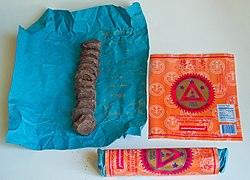Champorado
  Top: A bowl of champorado with milk; Bottom: Tabliya, locally made tablets of pure chocolate made from fermented, toasted, and ground cocoa beans | |
| Type | Porridge |
|---|---|
| Place of origin | Philippines |
| Serving temperature | Hot or cold |
| Main ingredients | Glutinous rice, tabliya, milk or coconut milk, sugar |
| Variations | Tinughong |
Champorado or tsampurado[1] (from Spanish: champurrado)[1] is a sweet chocolate rice porridge in Philippine cuisine.
Ingredients[]
It is traditionally made by boiling sticky rice with tablea (traditional tablets of pure ground roasted cocoa beans). It can be served hot or cold, usually for breakfast or merienda, with milk (or coconut milk) and sugar to taste. It is usually eaten as is, but a common pairing is with salted dried fish (daing or tuyo).
Tinughong is a variant of champorado in the Visayan-speaking regions of the Philippines. It is usually made by boiling sticky rice with sugar instead of tablea. Coffee or milk are sometimes added to it.[2][3]
History[]
Its history can be traced back from the Spanish colonial period of the Philippines. During the galleon trade between Mexico and the Philippines, Mexican traders brought the knowledge of making champurrado to the Philippines (on the way back, they introduced tuba in Mexico). Through the years, the recipe changed; Filipinos eventually found ways to make the Mexican champurrado a Philippine champorado by replacing masa with sticky rice.[4]
See also[]
- List of porridges
- Tsokolate
- Chocolate industry in the Philippines
 Food portal
Food portal
References[]
- ^ Jump up to: a b Almario, Virgilio, et al. 2010. UP Diksiyonaryong Filipino, 2nd ed. Anvil: Pasig.
- ^ Rose Catherine S. Tejano (16 December 2012). "Sikwate Stories". The Bohol Chronicle (344). Archived from the original on 13 August 2016. Retrieved 28 July 2016.
- ^ "Bisaya English Translation of "tinughong"". Cebuano Dictionary. Sandayong.com. Archived from the original on 14 September 2016. Retrieved 28 July 2016.
- ^ "Mexico Champorado". Retrieved 8 May 2018.
- Philippine rice dishes
- Porridges
- Chocolate desserts
- Milk dishes
